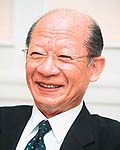
Vice Chairman, Nippon Keidanren
Chairman, Toshiba Corporation
 |
Taizo Nishimuro Vice Chairman, Nippon Keidanren Chairman, Toshiba Corporation |
The concerted and ceaseless efforts of the Japanese people to achieve Japan's post war reconstruction, from shortly after the war all the way through to recent years, resulted in Japan's emergence as the world second largest economy. However, there is now a widespread perception that the national framework that was a major factor in Japan's development, and that contributed to the country's continuous growth, no longer functions successfully. Everybody today recognizes that this frameworks stands in need of revision.
Of particular concern is the system of centralized government control. While its previous expansion allowed the achievement of a well-balanced nationwide development that extended to all parts of Japan, this system has recently has recently started to impede local government. It gets in the way of and stifles local initiatives and autonomous decision-making and action, and it undermines the original intent of local government itself.
Nippon Keidanren recently proposed a regeneration plan, Japan 2025 - Envisioning A Vibrant, Attractive Nation in the Twenty-First Century To explain it briefly, this means that central government should confine itself to complementary support for local governments in areas where they cannot act alone, but need real support from central government.
The essential reason for why relations between central and local government should be reconsidered comes from this understanding. The same approach should also be extended to relations between government-at all levels-and individuals.
There is a telling story from Niigata Prefecture, Kome Hyappyoo, which Prime Minister Koizumi likes to quote in his speeches.
Niigata lies north of central Japan. During the Edo era it was divided into different regions/districts, or Han, one of which was Nagaoka-Han. About 135 years ago, immediately after the Boshin War, the people of Nagaoka-Han faced a bad harvest and inevitable poverty. The neighboring lord sent the hungry people of Nagaoka 100 hyoos of rice contained in straw rice bags called tawara. Hyappyoo means 100 tawara rice bags. However, after a debate, Kobayashi, one of Nagaoka-Han's high ranking officers, persuaded his lord that the rice should not be eaten but sold, and the money raised should be used to build a school, to prepare for the growth and recovery expected in the future.
I recently participated in a meeting on educational reform that discussed reducing central government funds disbursed to local governments to support education. One of the participants criticized Koizumi's cabinet. He said that Koizumi always referred to the Kome Hyappyoo story, so he could not understand why he squeezed funds to support local education. I responded that the story actually recounts the local origin of the education system, and it supports Koizumi's plan rather than contradicts it. To eliminate the uniform guidelines and over-intervention by the central government is important, and an inevitable part of this is to reduce the funding that the central government provides to support compulsory education. Instead, there is a need for reconsideration and expectations of greater local self-sufficiency.
Let me tell you another story, that of Ms. Nami Takenaka of Kobe, who does voluntary work to help challenged people (she definitely prefers the word "challenged" in place of handicapped) to live independently.
Her experience prompts her to ask whether the current system of central government support gives too much, and sometimes spoils people, who often seem to be waiting for bota-mochi to fall from the sky. Bota-mochi is a Japanese rice cake covered with sweet bean paste; by bota-mochi falling from the sky, she means people who are just waiting for luck to happen to them but who make no effort to help themselves.
Ms. Takenaka's question understandably suggests that the future direction of the Japanese system needs to be changed from one of "Reliant-Protective" toward "Independent-Supportive".
Whenever we discuss the overall direction of Japan's system of central and local government, we would do well to recall Kome Hyappyoo and Bota-Mochi.